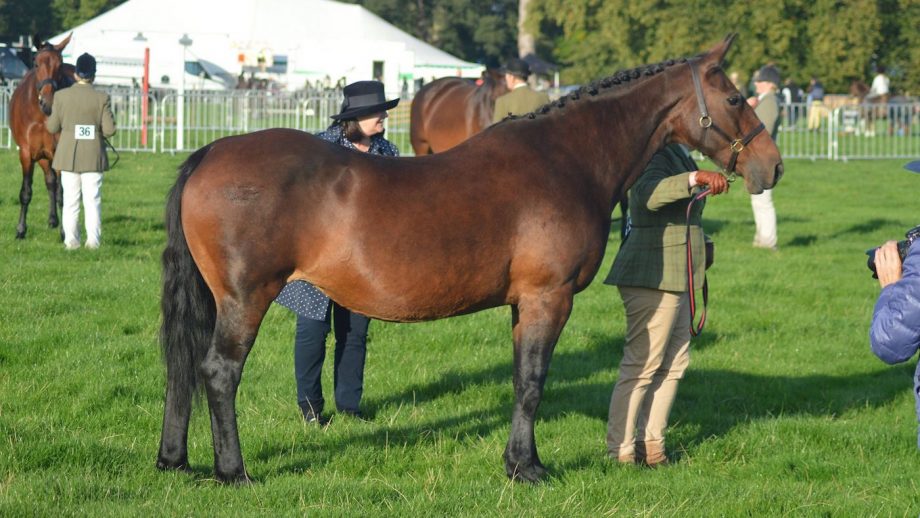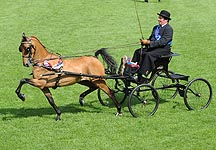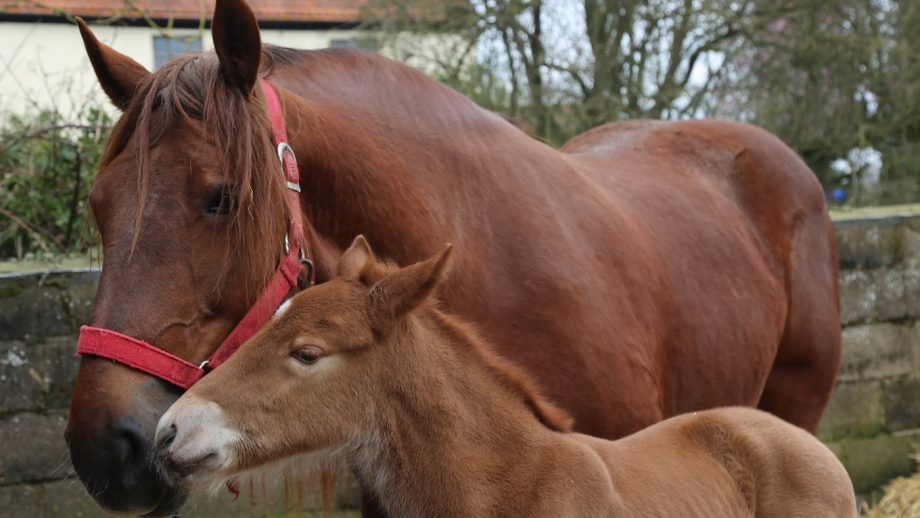Despite five of the 12 equine breeds on the Rare Breeds Survival Trust 2020/21 watchlist being described as ‘critical’, H&H finds some positive news from those working for the breeds’ futures...
The latest figures on endangered equines “shine a light” on the efforts of those working to save at-risk breeds.
There are 12 equine breeds on the Rare Breeds Survival Trust (RBST) 2020/21 watchlist, with five of those in the “critical” category, meaning there are fewer than 300 breeding females.
{"content":"PHA+VGhlcmUgaXMgc29tZSBnb29kIG5ld3MgYW1vbmcgc29tZSBvZiB0aGUgbW9yZSB3b3JyeWluZyBmaWd1cmVzLCB3aXRoIHNldmVyYWwgb2YgdGhlIG1vc3QgZW5kYW5nZXJlZCBicmVlZHMgc2hvd2luZyBwb3NpdGl2ZSBzaWducyBvZiBzdGFiaWxpc2luZyBhbmQsIGluIHNvbWUgY2FzZXMsIGluY3JlYXNpbmfCoHRoZWlyIG51bWJlcnMuPC9wPgo8cD7igJxUaGlzIHllYXLigJlzIHdhdGNobGlzdCBzaGluZXMgYSBsaWdodCBvbiB0aGUgZ3JlYXQgZWZmb3J0cyBvZiByYXJlLWVxdWluZSBicmVlZGVycyB3b3JraW5nIGFsb25nc2lkZSBSQlNULOKAnSBjaGllZiBleGVjdXRpdmUgb2YgdGhlIFJCU1QgQ2hyaXN0b3BoZXIgUHJpY2UgdG9sZCA8ZW0+SCZhbXA7SDwvZW0+LjwvcD4KPHA+4oCcSXQgaXMgZ3JlYXQgdG8gc2VlIHRoYXQsIHRocmVlIHllYXJzIGludG8gb3VyIGhlYXZ5IGhvcnNlIGNhbXBhaWduLCB0aGVpciBudW1iZXJzIGFyZSBzdGFibGUgd2l0aCBzb21lIGJyZWVkcyBzdWNoIGFzIHRoZSBTdWZmb2xrIHNob3dpbmcgYW4gaW5jcmVhc2Uu4oCdPC9wPgo8cD48ZGl2IGNsYXNzPSJhZC1jb250YWluZXIgYWQtY29udGFpbmVyLS1tb2JpbGUiPjxkaXYgaWQ9InBvc3QtaW5saW5lLTIiIGNsYXNzPSJpcGMtYWR2ZXJ0Ij48L2Rpdj48L2Rpdj48c2VjdGlvbiBpZD0iZW1iZWRfY29kZS0zMSIgY2xhc3M9ImhpZGRlbi1tZCBoaWRkZW4tbGcgcy1jb250YWluZXIgc3RpY2t5LWFuY2hvciBoaWRlLXdpZGdldC10aXRsZSB3aWRnZXRfZW1iZWRfY29kZSBwcmVtaXVtX2lubGluZV8yIj48c2VjdGlvbiBjbGFzcz0icy1jb250YWluZXIgbGlzdGluZy0tc2luZ2xlIGxpc3RpbmctLXNpbmdsZS1zaGFyZXRocm91Z2ggaW1hZ2UtYXNwZWN0LWxhbmRzY2FwZSBkZWZhdWx0IHNoYXJldGhyb3VnaC1hZCBzaGFyZXRocm91Z2gtYWQtaGlkZGVuIj4NCiAgPGRpdiBjbGFzcz0icy1jb250YWluZXJfX2lubmVyIj4NCiAgICA8dWw+DQogICAgICA8bGkgaWQ9Im5hdGl2ZS1jb250ZW50LW1vYmlsZSIgY2xhc3M9Imxpc3RpbmctaXRlbSI+DQogICAgICA8L2xpPg0KICAgIDwvdWw+DQogIDwvZGl2Pg0KPC9zZWN0aW9uPjwvc2VjdGlvbj48L3A+CjxwPkhlIGFkZGVkIHRoZXJlIGlzIGFsc28gcG9zaXRpdmUgbmV3cyBmb3IgdGhlIENsZXZlbGFuZCBCYXksIHdoaWNoIGhhcyBhbiBlc3RpbWF0ZWQgOTggYnJlZWRpbmcgZmVtYWxlcyByZWdpc3RlcmVkIGluIHRvdGFsLjwvcD4KPHA+4oCcSW4gMjAxOSwgMTggW25ld10gZmVtYWxlcyB3ZXJlIHJlZ2lzdGVyZWQsIHdoZXJlYXMgaW4gMjAxNiBqdXN0IGZpdmUgd2VyZSByZWdpc3RlcmVkLOKAncKgTXIgUHJpY2XCoHNhaWQuPC9wPgo8cD7igJxUaGlzIGlzIGEgcmVhbGx5IGltcG9ydGFudCBpbXByb3ZlbWVudCBidXQgdGhlIGJyZWVkIHJlbWFpbnMgaW4gYSBjcml0aWNhbCBwb3NpdGlvbiBhbmQgc28gb3VyIGVmZm9ydHMgdG8gc2FmZWd1YXJkIHRoZWlyIGZ1dHVyZSBjb250aW51ZSwgaW4gY2xvc2UgY29sbGFib3JhdGlvbiB3aXRoIHRoZSBDbGV2ZWxhbmQgQmF5IEhvcnNlIFNvY2lldHkuPC9wPgo8ZGl2IGNsYXNzPSJhZC1jb250YWluZXIgYWQtY29udGFpbmVyLS1tb2JpbGUiPjxkaXYgaWQ9InBvc3QtaW5saW5lLTMiIGNsYXNzPSJpcGMtYWR2ZXJ0Ij48L2Rpdj48L2Rpdj4KPHA+4oCcVGhlc2UgaW5jcmVhc2VzIGFyZSBoZWFydGVuaW5nLCBidXQgdGhleSBhcmUgaW4gdGhlIGNvbnRleHQgb2YgZ2VuZXJhbGx5IGRlY2xpbmluZyBudW1iZXJzIG9mIHJhcmUtYnJlZWQgcG9uaWVzIGFuZCBob3JzZXMgb3ZlciB0aGUgcGFzdCBkZWNhZGUu4oCdPC9wPgo8cD5JbiAyMDExLCA8ZW0+SCZhbXA7SDwvZW0+IHJlcG9ydGVkIHRoZSBudW1iZXIgb2YgaGFja25leSBicmVlZGluZyBtYXJlcyBoYWQgZHJvcHBlZCBmcm9tIDUwMCB0byBhcm91bmQgMzAwLCB3aGljaCBoYXMgbW9yZSB0aGFuIGhhbHZlZCBhZ2FpbiBkdXJpbmcgdGhlIHBhc3QgbmluZSB5ZWFycy48L3A+CjxkaXYgY2xhc3M9ImFkLWNvbnRhaW5lciBhZC1jb250YWluZXItLW1vYmlsZSI+PGRpdiBpZD0icG9zdC1pbmxpbmUtNCIgY2xhc3M9ImlwYy1hZHZlcnQiPjwvZGl2PjwvZGl2Pgo8cD7igJxUaGUgZml2ZSBicmVlZHMgaW4gb3VywqBjcml0aWNhbMKgY2F0ZWdvcnkgaGF2ZSB2ZXJ5IGxvdyBudW1iZXJzLCB3aXRoIGhhY2tuZXkgaG9yc2UgbnVtYmVycyBkZWNsaW5pbmcgZnVydGhlciB0byBhbiBlc3RpbWF0ZWQgYnJlZWRpbmcgbnVtYmVyIG9mIDEyOSBhbmQgdGhlIEVyaXNrYXkgYnJlZWQgb25seSByZWdpc3RlcmluZyBmb3VyIGZlbWFsZSBmb2FscyBpbiAyMDE5LOKAnSBoZSBhZGRlZC4g4oCcVGhlIHR3b8KgZW5kYW5nZXJlZMKgYnJlZWRzIOKAkyBFeG1vb3IgcG9uaWVzIGFuZCBEYXJ0bW9vciBwb25pZXMg4oCTIGhhdmUgYm90aCBkZWNyZWFzZWQgaW4gbnVtYmVyLuKAnTwvcD4KPHA+SGUgYWRkZWQgdGhlIFJCU1QgaGFzIHZpdGFsIGNvbnNlcnZhdGlvbiBwcm9ncmFtbWVzIHVuZGVyIHdheSB0byBzYXZlIGJyZWVkcyBtb3N0IGF0IHJpc2sgYW5kIHRoYW5rZWQgYWxsIHRob3NlIHdobyBzdXBwb3J0IHRoaXPCoOKAnGNydWNpYWwgd29ya+KAnS48L3A+CjxkaXYgY2xhc3M9ImFkLWNvbnRhaW5lciBhZC1jb250YWluZXItLW1vYmlsZSI+PGRpdiBpZD0icG9zdC1pbmxpbmUtNSIgY2xhc3M9ImlwYy1hZHZlcnQiPjwvZGl2PjwvZGl2Pgo8cD5CYXJiYXJhIFN0b2NrdG9uLCBvZiB0aGUgSGFja25leSBIb3JzZSBTb2NpZXR5LCBoYXMgYmVlbiBleGhpYml0aW5nIGFuZCBicmVlZGluZyBoYWNrbmV5cyBzaW5jZSB0aGUgMTk3MHMsIGp1ZGdpbmcgZm9yIHRoZSBwYXN0IDMwIHllYXJzLCBhbmQgc3BlbnQgZml2ZSB5ZWFycyBhcyB0aGUgc29jaWV0eeKAmXMgY2hhaXJtYW4uPC9wPgo8cD7igJxPYnZpb3VzbHkgdGhlIGRlY2xpbmUgaXMgaW5jcmVkaWJseSBzYWQs4oCdIHNoZSB0b2xkIEgmYW1wO0guIOKAnFRoZSBwaWN0dXJlIHdlIHNlZSBhcyBhIGJyZWVkIHNvY2lldHkgaXMgcG9zc2libHkgc2xpZ2h0bHkgZGlmZmVyZW50IHRvIHRoZSBSQlNUIOKAkyB3ZSBhcmUgYWN0dWFsbHkgc2VlaW5nIFtvdmVyYWxsXSByZWdpc3RyYXRpb25zIGluY3JlYXNpbmcgc2xvd2x5LCBidXQgc3VyZWx5LuKAnTwvcD4KPHA+U2hlIGFkZGVkIHRoZXJlIHdhcyBvbmUgdmVyeSBsb3cgeWVhciBpbiB0aGUgcGFzdCBmaXZlIHllYXJzIHdpdGggYWJvdXQgMjUgbmV3IHJlZ2lzdHJhdGlvbnMsIGJ1dCB0aGUgMjAxOSB0b3RhbHMgYXJlIGFyb3VuZCA2Mi48L3A+CjxkaXYgY2xhc3M9ImluamVjdGlvbiI+PC9kaXY+CjxwPkdlbmUgcG9vbCBtYXBwaW5nIHdvcmsgaXMgYmVpbmcgZG9uZSBieSB0aGUgUkJTVCBhbmQgTXJzIFN0b2NrdG9uIGFkZGVkIG9uZSBvZiB0aGUgcGx1c2VzIG9mIHRoZSBicmVlZCBpcyBvd25lcnMgdGVuZCB0byBrZWVwIHRoZSBzdGFsbGlvbnMgZW50aXJlLCB1bmxlc3MgdGhlcmUgaXMgYSByZWFzb24gZm9yIHRoZW0gdG8gYmUgY3V0LjwvcD4KPHA+4oCcSSBoYXZlIGJlZW4gYSBmYW4gb2YgdGhlIGhvcnNlcyBmb3Igc28gbWFueSB5ZWFycyBhbmQgSSBjYW5ub3QgdW5kZXJzdGFuZCB3aHkgYSBob3JzZSB3aXRoIHNvIG1hbnkgZ3JlYXQgYXR0cmlidXRlcyBpc27igJl0IHRha2VuIG9uIGJ5IG1vcmUgcGVvcGxlLOKAncKgc2hlIHNhaWQuwqDigJxUaGV5IGFyZSBpbmNyZWRpYmx5IGF0aGxldGljLCB0aGVpciBzdGFtaW5hIGlzIGFtYXppbmcgYW5kIGFyZSBhIG5hdHVyYWxseSBlbGVnYW50LCBiZWF1dGlmdWwgYnJlZWQu4oCdPC9wPgo8cD4K"}
You may also be interested in…
Credit: Maggie Brown
The mare has had a significant impact on the breed, in the UK and abroad
Credit: Suffolk Horse Society
Coppermantle Big Stig was born on 8 March
‘Hopefully this may be a way to stop these breeds from disappearing’
The future of the hackney horse hangs in the balance with less than 300 breeding mares now registered
Footage from Emma Massingale's exciting trip will be aired on the BBC’s The One Show later this year
Stay in touch with all the news in the run-up to and throughout the major shows and events during 2025 and beyond with a Horse & Hound subscription. Subscribe today for all you need to know ahead of these major events, plus online reports on the action as it happens from our expert team of reporters and in-depth analysis in our special commemorative magazines. Have a subscription already? Set up your unlimited website access now
H&H senior news writer
Lucy is an experienced news journalist, reporter and presenter. Since joining the Horse & Hound team in 2015, Lucy has reported from major global sporting events including the Tokyo Paralympic Games and multiple European Championships, as well as Badminton, Burghley and London, to name a few. She has covered current affairs and sports news across the full spectrum of equestrian disciplines and racing, as well as human and equine welfare, industry news and court cases.






